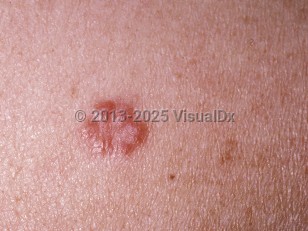Sarcoidosis - External and Internal Eye
See also in: Overview,Hair and Scalp,Oral Mucosal LesionAlerts and Notices
Important News & Links
Synopsis

Sarcoidosis commonly presents with abnormalities identified incidentally on chest radiography. Although the disease can affect different organs, systemic symptoms such as fever, night sweats, and weight loss are common. Sarcoidosis can affect the lungs, with symptoms such as chest pain, shortness of breath, cough, and most commonly, pronounced fatigue. It can also affect the peripheral lymph nodes, heart, kidneys, gastrointestinal tract, central nervous system (CNS), liver, spleen, bone, muscle, and endocrine glands. Venous thromboembolism and pulmonary hypertension are potential complications of sarcoidosis. Approximately 90% of patients will have lung involvement. Pulmonary fibrosis and bronchiolectasis result in "honeycombing" of the lung and represent end-stage lung disease due to chronic granulomatous inflammation. Hilar lymphadenopathy is asymptomatic and affects 90% of patients. Approximately 10% of patients have hypercalcemia.
Neurosarcoidosis commonly manifests as cranial-nerve deficits. Any part of the neurologic system can be impacted by sarcoidosis; a vast range of neurologic signs and symptoms may be present. Delays in diagnosis and treatment can lead to permanent disability. The diagnostic workup for neurosarcoidosis should include an MRI of the head, cerebrospinal fluid analysis, and detection of sarcoidosis outside the nervous system.
About a quarter to one-half of patients with systemic disease develop eye involvement. Patients with ocular sarcoid may complain of double, decreased, or blurry vision. There are 2 ocular syndromes: Heerfordt syndrome, with uveitis, parotid enlargement, and papilledema; and Löfgren syndrome, with erythema nodosum, bilateral hilar adenopathy, and arthralgias.
Uveitis of the eye can present with photophobia, redness of the eye, and cloudy vision. Complications from uveitis include cataracts, glaucoma, posterior synechiae, corneal band keratopathy, and iris nodules. Retinal neovascularization and optic nerve damage are also possible with sarcoidosis. Granulomas of the eyelids, lacrimal glands, conjunctiva, iris, retina, and choroid can occur. Rarely, there can be granulomatous inflammation of the extraocular muscles leading to diplopia, which may be the presenting sign of sarcoidosis.
Mortality is most commonly due to significant granulomatous disease in the lungs and heart, leading to respiratory failure, cardiac arrhythmias, and heart failure. CNS, liver, and renal diseases are also well-known causes of morbidity and mortality.
The pathogenesis of sarcoidosis is poorly understood. However, it is characterized by noncaseating epithelioid granulomas made up mostly of CD4+ helper T-cells, a predominantly Th1 type immune response, and elevated levels of interferon (IFN)-gamma and interleukin (IL)-2.
Some drugs and exposures have been associated with the development of sarcoidosis and sarcoid-like granulomatosis. Patients undergoing antiviral therapy for chronic hepatitis C – both monotherapy with IFN-alpha and combination therapy with IFN-alpha and ribavirin – have developed new-onset sarcoidosis or experienced reactivation of preexisting sarcoidosis during or shortly after treatment. The disease typically manifests as pulmonary and/or cutaneous sarcoidosis and follows a benign course, resolving spontaneously or within months after antiviral treatment is completed. More complicated multisystem cases, eg, involving the CNS, have been reported. The use of systemic corticosteroids to treat sarcoidosis in such patients should be considered with caution due to their adverse effects on viral loads. In addition, there have been an increasing number of reports of new-onset sarcoidosis manifesting in patients who are receiving anti-tumor necrosis factor (TNF)-alpha therapy (etanercept, infliximab, adalimumab), eg, for a rheumatologic diagnosis. This is paradoxical because TNF-alpha inhibitors have been used to treat sarcoidosis. Disease typically resolves with discontinuation of the drug and steroid therapy. It has been reported that exposure to moderate-to-high levels of silica increases the risk for sarcoidosis, which is of special concern for first responders (eg, firefighters). This association is more common in men due to occupational exposure.
Pediatric patient considerations: Sarcoidosis is an uncommon disease in pediatric patients and is extremely rare in children younger than 6 years. When sarcoidosis presents in children younger than 6 years, it is characterized by a triad of skin rash, uveitis, and arthritis without intrathoracic involvement. In adolescents, the cutaneous manifestations of sarcoidosis are similar to those seen in adults, with the exception of lupus pernio and erythema nodosum, which are rare in that age group.
Codes
D86.3 – Sarcoidosis of skin
SNOMEDCT:
31541009 – Sarcoidosis
Look For
Subscription Required
Diagnostic Pearls
Subscription Required
Differential Diagnosis & Pitfalls

Subscription Required
Best Tests
Subscription Required
Management Pearls
Subscription Required
Therapy
Subscription Required
Drug Reaction Data
Subscription Required
References
Subscription Required
 Patient Information for Sarcoidosis - External and Internal Eye
Patient Information for Sarcoidosis - External and Internal Eye- Improve treatment compliance
- Reduce after-hours questions
- Increase patient engagement and satisfaction
- Written in clear, easy-to-understand language. No confusing jargon.
- Available in English and Spanish
- Print out or email directly to your patient


